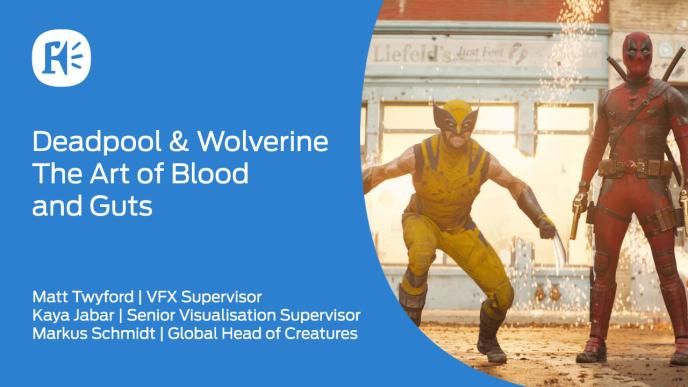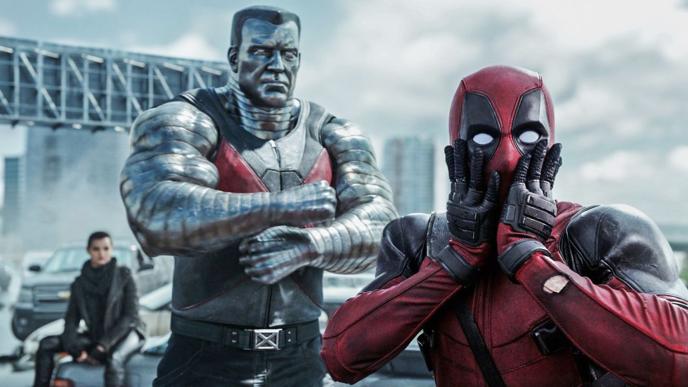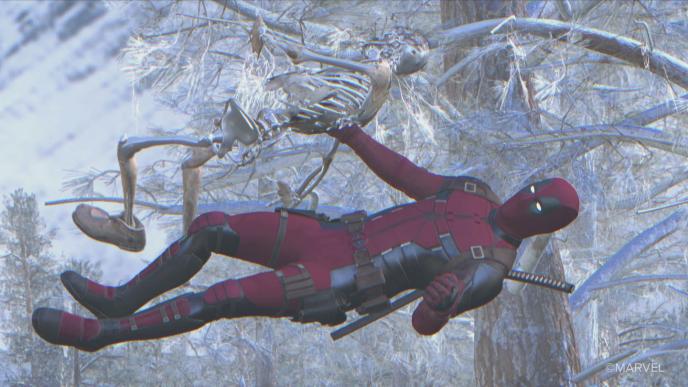
Deadpool & Wolverine
Pour sa dernière rencontre avec le « Merc with a Mouth », Framestore s'est embarqué dans une course effrénée. Des services de préproduction (previz, assistance sur le plateau, techviz et postviz) à la magie des effets visuels, Framestore a donné vie au premier spectacle classé R du MCU. Supervisée par les superviseurs VFX Matt Twyford (Loki), Robert Allman, Arek Komorowski et João Sita, l'équipe VFX de Framestore a réalisé 420 plans extrêmement complexes, en s'appuyant sur le travail de base réalisé par l'équipe de préproduction de Framestore (FPS), dirigée par le superviseur principal de la visualisation Kaya Jabar.

Deadpool Corp et les séquences d'Oner
Le troisième acte du film commence avec Deadpool et Wolverine affrontant le Deadpool Corps. Framestore a créé certains des éléments les plus intéressants de cette séquence, notamment Canadianpool, Headpool et Babypool.

Cette séquence impressionnante se compose de 200 plans, réalisés par la talentueuse équipe de Vancouver dirigée par Arek Komorowski. Elle met en scène un vaste environnement urbain inspiré de New York, Chicago et Vancouver, 120 cascades, des douzaines de prises de vue en digi-double, qui ont toutes nécessité une planification et une préparation méticuleuses.
Le fait que tout le travail de préproduction soit effectué par l'équipe FPS de Framestore a eu un impact considérable sur l'efficacité et le temps de préparation de l'équipe VFX de Framestore. « Notre équipe FPS a planifié l'ensemble de la séquence dans previz, programmé le contrôle des mouvements, supervisé le tournage et géré la postviz pendant que nous réalisions les effets visuels finaux », explique Matt Twyford, superviseur des effets visuels. « En conservant le concept tout au long du tournage et en faisant préparer le tout par Kaya et son équipe, nous avons pris un départ fulgurant lorsqu'il s'est agi de créer des ressources, d'installer des caméras, de développer le look et d'arranger les coupes. Les cascades complexes de cette séquence se sont étalées sur plus de six mois, exigeant une synchronisation et une coordination précises. L'équipe du SFP a joué un rôle crucial en aidant l'équipe VFX à déterminer le timing, la vitesse et la chorégraphie exacts pour chaque cascade, y compris le saut complexe dans le bus. Ensuite, l'équipe VFX a dû relever un défi monumental en matière de compositing pour intégrer de manière transparente les différents éléments de cette séquence.


« Cette séquence a représenté un énorme défi en composition, nécessitant la gestion d'une quantité de données colossale », déclare Twyford. « Nous avons assemblé plusieurs plans et intégré plus de 400 couches d’éléments en CG. De plus, nous avons simulé des effets de sang pour 66 personnages et suivi les mouvements corporels de 67 personnages. Le résultat est une œuvre incroyablement fluide et efficace d'effets invisibles. »
In Over Your Head
L'un des effets les plus remarquables de Framestore est garanti de laisser une impression durable : la séquence où Cassandra insère sa main à travers la tête de l'agent de la TVA, Mr. Paradox (Matthew Macfayden), et fouille à l'intérieur de son cerveau dans un plan à la fois grotesque et extrêmement détaillé.
C'est quelque chose qui n'a jamais été fait auparavant ; c'était presque un projet à part entière. C'était à la fois techniquement original et un défi créatif. Nous avons mobilisé nos ressources mondiales pour rendre cet effet aussi réussi que possible.

En utilisant les références des bandes dessinées fournies par l'équipe de production, l'équipe de développement visuel (VisDev) de Framestore a travaillé sur des rendus préliminaires, offrant des visuels réalistes peints à la main qui ont permis des itérations rapides. Ce processus a été crucial pour affiner les séquences, en particulier l'interaction entre la main et le visage de Paradox. Une fois une version satisfaisante approuvée, l'implémentation technique a commencé, garantissant des résultats de haute qualité et cohérents sur tous les plans.

L'équipe des effets visuels a commencé par créer un double numérique extrêmement détaillé de Matthew Macfayden, en utilisant un scanner Dorothy ultra-haute résolution de Clear Angle aux studios de Pinewood. Le bras et les doigts de Cassandra ont également été scannés pour alimenter les simulations. L'une des principales stratégies consistait à orienter l'apparence principale de l'interaction avec la peau vers l'étape d'animation. Cette approche a nécessité la création d'une plateforme d'animation personnalisée permettant aux animateurs de définir rapidement et avec précision les déformations et intersections significatives de la peau tout en préservant l'intégrité de la performance jusqu'aux simulations finales.
« En orientant l'apparence principale de l'interaction avec la peau vers l'étape d'animation, nous avons obtenu une validation précoce, ce qui nous a donné la confiance nécessaire pour avancer avec des simulations lourdes et des rendus complexes, tout en atteignant un effet final plus soigné et cohérent », explique Twyford.
La configuration du rig sous Maya a nécessité la création d’un rig facial haut de gamme basé sur le système FACS, avec des formes modélisées à la main et issues de scans, ainsi qu’un rig de main détaillé enrichi de formes PSD conçues manuellement. Ce rig devait interagir de manière crédible avec la main et les doigts utilisés comme colliders, offrant aux animateurs une représentation précise dans leurs viewports de ce qui serait rendu par la suite, après les étapes supplémentaires de simulation d'effets et de sculpture par plan.
Le système FX a été conçu pour être hautement modulaire. Cette modularité a permis de décomposer tous les éléments contribuant à l’effet final sur la peau, facilitant ainsi l’ajustement précis de caractéristiques comme la profondeur des plis. « Nous avons établi une hiérarchie entre les plis, les rides et les micro-rides », explique Markus Schmidt, Responsable Global des Créatures. « Tout comme notre équipe de rigging, l’équipe FX a excellé en s’assurant que les configurations de base puissent être appliquées à de nouveaux plans, en fournissant des résultats initiaux cohérents sans nécessiter trop d’ajustements manuels. Cette efficacité a permis de livrer un grand nombre de plans dans des délais serrés et de transférer les effets à d’autres assets. »


Préserver la performance de Matthew Macfadyen était un autre aspect crucial. Bien qu'un scan de tête haute résolution et un ensemble complet de FACS aient été disponibles, une quantité importante d'animation manuelle et de suivi de la tête a été nécessaire pour conserver les nuances subtiles de l'interprétation de l'acteur. Les séquences tournées ont servi de référence pour s'assurer de reproduire et de vérifier systématiquement les petits détails. La touche finale pour rendre crédibles les déformations légèrement surréalistes de la main sous la peau a été l’utilisation de nombreux marqueurs visuels pour un réalisme accru, tels qu’un flux sanguin dynamique dans le lookdev, ainsi que des comportements complexes hiérarchiques des plis et des rides de la peau.
« L’effet est au premier plan dans de nombreux plans, ce qui ne laisse aucune place à l’erreur », explique Schmidt. « Nous voulions qu’il soit aussi réaliste que possible pour que le public ne se concentre pas sur la manière dont l’effet a été réalisé, mais soit plutôt entièrement captivé par les performances des acteurs, au point de presque ressentir physiquement les doigts de Cassandra sous leur propre peau. »
Magnifier les yeux de Dogpool
Dogpool, interprété par Peggy, couronnée chien le plus laid de Grande-Bretagne, a présenté des défis uniques. Bien qu'essentiellement pratique, plusieurs plans ont nécessité des yeux entièrement améliorés en CG. La tâche consistait à remplacer et animer les yeux tout en intégrant de manière transparente les éléments CG pour les agrandir dans les plans en prise de vue réelle.


L'équipe des assets de Framestore à Londres a développé l'asset CG pour Dogpool, en se concentrant sur la création d'yeux photoréalistes mais comiquement exagérés. Cet asset a ensuite été transmis à l'équipe de Melbourne, dirigée par le superviseur VFX João Sita, pour l'intégration dans les plans. En plus de l'animation des yeux, l'équipe a ajouté des éléments CG décalés, notamment des lunettes épaisses au-dessus des yeux et une boucle d'oreille assortie pour Nicepool.

« En animant uniquement les yeux, nous avons pu donner à Dogpool un tout nouveau caractère avec plus de présence et d’intention dans sa performance », explique Twyford. « Le défi consistait à trouver et à maintenir le juste équilibre entre des yeux réalistes et photoréalistes, et le style exagéré et cartoon qui nous permettait d’insuffler plus de personnalité et d’émotion à Dogpool. Tout cela devait être réalisé derrière les lunettes épaisses qui amplifient les yeux, ce qui nous obligeait à prendre en compte la physique du verre. »

En utilisant des yeux humains comme références, l'équipe a affiné l'iris, les pupilles, les réflexions et le ménisque pour enrichir la gamme d'émotions. L'animation des yeux a été ajustée plan par plan en fonction de la scène, des dialogues et des actions réalisées par Dogpool. Ce travail minutieux comprenait l'éclairage esthétique, les réflexions et l'ajustement de la visibilité des yeux à travers la visière.
Nous nous sommes vraiment concentrés sur le rendu des yeux : la quantité de blanc dans les yeux, l'expression des yeux, puis l'intégration des yeux avec les lunettes par-dessus.


L'un des principaux défis était de reproduire l'effet de réfraction avec l'aspect « globuleux » des yeux de Dogpool sans trop de distorsion. « L'équipe d'animation a livré une performance crédible et captivante en travaillant sur les yeux avant d'ajouter les lunettes, afin de s'assurer que l'animation restait ancrée dans le réalisme. Nous avons ensuite rendu les scènes pour vérifier que l'effet d'agrandissement ne s'écartait pas de l'animation souhaitée et que les yeux étaient correctement orientés. Maintenir la lisibilité des yeux tout en ajustant les blancs et l'aspect humide était essentiel pour l'engagement émotionnel et la performance globale », explique Sita. L'équipe a également rendu plusieurs passes des yeux en éclairage, permettant au compositing d'ajuster la forme des yeux et d'équilibrer la réfraction. « Le compositing a été crucial pour affiner notre animation et intégrer les éléments de manière cohérente. Bien que la performance des yeux puisse être un peu comique, elle n'en reste pas moins réaliste. »
C'était une collaboration solide entre plusieurs sites, et nous avons travaillé main dans la main avec d'autres studios de Framestore pour échanger les compositions et pré-compositions entre les différents sites.
« Notre collaboration avec l'équipe des assets de Londres nous a également beaucoup aidés à intégrer de manière fluide les éléments CG avec les prises de vue réelles. Grâce à eux, nous avons pu peaufiner l'asset de Dogpool, le grooming de la fourrure qui recouvre les lunettes, ainsi que le design et le travail sur les shaders des lunettes et de la visière. Nous avons ainsi pu offrir une performance amusante et unique pour le "Merc with a Bark". »

Destruction de la machine Time Ripper : spaghettification et atomisation
L'acte final spectaculaire du film le plus fou et le plus brutal de Marvel n'aurait pas pu être mieux pris en charge que par notre équipe de Londres, dirigée par le superviseur VFX Robert Allman, dont le travail incluait la livraison des effets de « spaghettification » de la séquence. « Le dernier acte est colossal et vraiment très complexe », explique Twyford. « Il traite de plusieurs intrigues que nous avons dû intégrer simultanément, certaines nouvelles, d'autres anciennes, certaines retravaillées à partir de divers projets Marvel, le tout se rejoignant à un point précis dans le temps. Cela nous a obligés à reconstruire d'anciens assets, à en créer de nouveaux et à les fusionner de manière transparente. »


Dans cet acte final, Cassandra tente de détruire le Time Ripper, une énorme machine aux mécaniques complexes et en verre, alimentée par deux sources de matière, capable de déchirer les lignes temporelles. La détruire entraînera finalement l'anéantissement de toutes les lignes temporelles de l'univers. Pour l'arrêter, Wolverine et Deadpool doivent court-circuiter son alimentation énergétique. Notre équipe a pris en charge cette séquence de destruction massive sur plus de 80 plans, avec de multiples couches d'effets complexes. De l'illustration de l'énergie antagoniste à travers les corps de Deadpool et Wolverine, à la destruction de la machine Time Ripper et l'atomisation finale de Cassandra, en gros plan.
« Nos artistes FX ont livré un travail exceptionnel, rendant cette tâche complexe apparemment sans effort », explique Allman. « Cette séquence difficile impliquait des physiques complexes, créant de la chair géométrique arrachée à un digi-double qui devait conserver la ressemblance de Cassandra. Le travail sur le digi-double a été réalisé avec une précision méticuleuse. Cassandra est entièrement en CG, mais pour obtenir une ressemblance convaincante, en particulier au niveau des yeux, l’équipe a soigneusement restauré ses yeux et ses sourcils pour capturer ses expressions avec précision. Leur travail d'intégration sans faille rend presque impossible de dire qu’il s'agit d'une Cassandra en CG. »

Pour cette séquence également, la collaboration avec l'équipe FPS a été cruciale et a simplifié le processus créatif et de production. « Les standards de notre équipe FPS étaient impressionnamment élevés. Ils excellent dans le storytelling et le travail narratif, ce qui en fait des designers efficaces. Alors que de nombreux artistes VFX se concentrent sur la simulation et le réalisme, FPS apporte une perspective de design qui renforce l’attrait visuel », note Allman. « En utilisant les layouts de FPS, nous avons obtenu de meilleurs résultats instantanément. Leur capacité à combiner les besoins narratifs avec l’esthétique visuelle est rare et a largement influencé notre travail. »

Deadpool & Wolverine: The Art of Blood & Guts
From pre-production to final VFX, Framestore’s teams crafted over 420 complex, and gloriously bloody, shots for Deadpool & Wolverine. This webinar takes you deep into the most Deadpool-esque sequences.
VFX Supervisor Matt Twyford and Senior Visualization Supervisor Kaya Jabar break down everything from previsualization and on-set support to postvisualization and the final seamless stitch of The Bus Oner.
Global Head of Creatures Markus Schmidt reveals the creative and technical challenges behind Cassandra’s unsettling “hands-through-face” power and Paradox’s gloriously disturbing facial distortions.
You can also explore more of Markus’s work in his blog post here.












